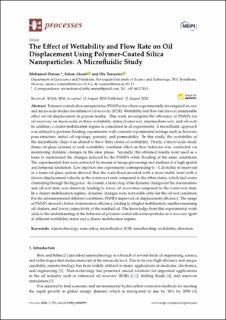| dc.contributor.author | Omran, Mohamed Ahmed Fathy Abdelshafy | |
| dc.contributor.author | Akarri, Salem Saeed Fadhl | |
| dc.contributor.author | Torsæter, Ole | |
| dc.date.accessioned | 2020-09-07T12:43:36Z | |
| dc.date.available | 2020-09-07T12:43:36Z | |
| dc.date.created | 2020-08-15T21:17:45Z | |
| dc.date.issued | 2020 | |
| dc.identifier.citation | Processes. 2020, 8 (991), 1-14. | en_US |
| dc.identifier.issn | 2227-9717 | |
| dc.identifier.uri | https://hdl.handle.net/11250/2676698 | |
| dc.description.abstract | Polymer-coated silica nanoparticles (PSiNPs) have been experimentally investigated in core- and micro-scale studies for enhanced oil recovery (EOR). Wettability and flow rate have a considerable effect on oil displacement in porous media. This work investigates the efficiency of PSiNPs for oil recovery on micro-scale at three wettability states (water-wet, intermediate-wet, and oil-wet). In addition, a cluster mobilization regime is considered in all experiments. A microfluidic approach was utilized to perform flooding experiments with constant experimental settings such as flowrate, pore-structure, initial oil topology, porosity, and permeability. In this study, the wettability of the microfluidic chips was altered to have three states of wettability. Firstly, a micro-scale study (brine-oil-glass system) of each wettability condition effect on flow behavior was conducted via monitoring dynamic changes in the oleic phase. Secondly, the obtained results were used as a basis to understand the changes induced by the PSiNPs while flooding at the same conditions. The experimental data were extracted by means of image processing and analysis at a high spatial and temporal resolution. Low injection rate experiments (corresponding to ~1.26 m/day in reservoir) in a brine-oil-glass system showed that the waterflood invaded with a more stable front with a slower displacement velocity in the water-wet state compared to the other states, which had water channeling through the big pores. As a result, a faster stop of the dynamic changes for the intermediate- and oil-wet state was observed, leading to lower oil recoveries compared to the water-wet state. In a cluster mobilization regime, dynamic changes were noticeable only for the oil-wet condition. For the aforementioned different conditions, PSiNPs improved oil displacement efficiency. The usage of PSiNPs showed a better clusterization efficiency, leading to a higher mobilization, smaller remaining oil clusters, and lower connectivity of the residual oil. The knowledge from this experimental work adds to the understanding of the behavior of polymer-coated silica nanoparticles as a recovery agent at different wettability states and a cluster mobilization regime. | en_US |
| dc.language.iso | eng | en_US |
| dc.publisher | MDPI | en_US |
| dc.rights | Navngivelse 4.0 Internasjonal | * |
| dc.rights.uri | http://creativecommons.org/licenses/by/4.0/deed.no | * |
| dc.subject | Økt oljeutvinning | en_US |
| dc.subject | Enhanced Oil Recovery | en_US |
| dc.subject | Reservoarteknikk | en_US |
| dc.subject | Reservoir Engineering | en_US |
| dc.subject | Porøse medier | en_US |
| dc.subject | Porous media | en_US |
| dc.title | The effect of wettability and flow rate on oil displacement using polymer-coated silica nanoparticles: A microfluidic study | en_US |
| dc.type | Peer reviewed | en_US |
| dc.type | Journal article | en_US |
| dc.description.version | acceptedVersion | en_US |
| dc.subject.nsi | VDP::Petroleumsteknologi: 512 | en_US |
| dc.subject.nsi | VDP::Petroleum engineering: 512 | en_US |
| dc.source.pagenumber | 1-14 | en_US |
| dc.source.volume | 8 | en_US |
| dc.source.journal | Processes | en_US |
| dc.source.issue | 991 | en_US |
| dc.identifier.doi | 10.3390/pr8080991 | |
| dc.identifier.cristin | 1823465 | |
| dc.relation.project | Norges forskningsråd: 262644 | en_US |
| dc.description.localcode | © 2020 by the authors. Licensee MDPI, Basel, Switzerland. This article is an open accessarticle distributed under the terms and conditions of the Creative Commons Attribution(CC BY) license (http://creativecommons.org/licenses/by/4.0/). | en_US |
| cristin.ispublished | true | |
| cristin.fulltext | postprint | |
| cristin.qualitycode | 1 | |

